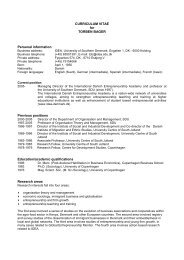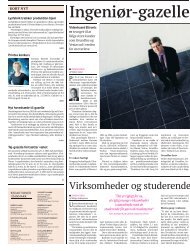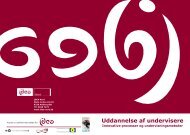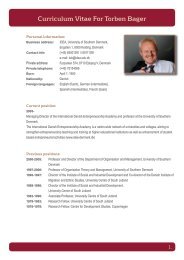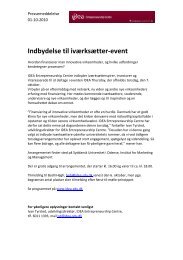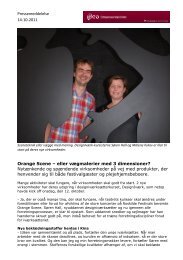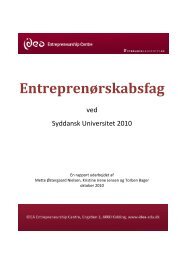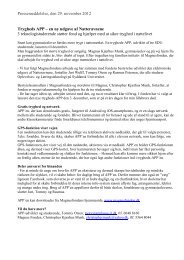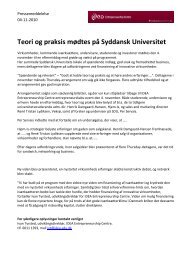Education, Training and Networking for Entrepreneurship in ...
Education, Training and Networking for Entrepreneurship in ...
Education, Training and Networking for Entrepreneurship in ...
You also want an ePaper? Increase the reach of your titles
YUMPU automatically turns print PDFs into web optimized ePapers that Google loves.
The ex-owner-managers are those answer<strong>in</strong>g<br />
Yes to the follow<strong>in</strong>g question,<br />
Have you, <strong>in</strong> the past twelve months, shut down,<br />
discont<strong>in</strong>ued or quit a bus<strong>in</strong>ess you owned <strong>and</strong><br />
managed, any <strong>for</strong>m of self-employed, or sell<strong>in</strong>g<br />
goods or services to anyone (not count<strong>in</strong>g a<br />
bus<strong>in</strong>es that was sold)?<br />
The <strong>in</strong>vestors are those answer<strong>in</strong>g Yes to the<br />
follow<strong>in</strong>g question,<br />
Have you, <strong>in</strong> the past three years, personally<br />
provided funds <strong>for</strong> a new bus<strong>in</strong>ess started by<br />
someone else (exclud<strong>in</strong>g any purchases of<br />
stocks or mutual funds)?<br />
A person may of course play more than one of<br />
the above six specialized roles.<br />
Here we focus on the early phases of entrepreneurship.<br />
We ignore discont<strong>in</strong>uations <strong>and</strong> <strong>in</strong>vest<strong>in</strong>g<br />
(Schøtt, 2008).<br />
The level of each entrepreneurial activity <strong>in</strong><br />
Denmark <strong>in</strong> a year can be estimated by the<br />
prevalence or rate of the so-identified entrepreneurs<br />
<strong>in</strong> our surveyed sample of the adult population,<br />
Table 3.1 (observations are weighted,<br />
thereby enhanc<strong>in</strong>g validity). An entrepreneur<br />
may of course be more than one specialized<br />
k<strong>in</strong>d of entrepreneur, <strong>and</strong> thus be <strong>in</strong>cluded more<br />
than once <strong>in</strong> the counts, so the total rate of entrepreneurship<br />
of several k<strong>in</strong>ds is somewhat<br />
less than the sum of the rates of specialized<br />
k<strong>in</strong>ds of entrepreneurship.<br />
The rate of prospective starters has apparently<br />
been decl<strong>in</strong><strong>in</strong>g <strong>in</strong> recent years, which is quite<br />
surpris<strong>in</strong>g consider<strong>in</strong>g the considerable ef<strong>for</strong>ts<br />
to promote <strong>in</strong>terest <strong>in</strong> entrepreneurship.<br />
The rate of starters actively try<strong>in</strong>g to start has<br />
apparently been rather stable over recent years<br />
with some fluctuations; that it has not <strong>in</strong>creased<br />
is also surpris<strong>in</strong>g consider<strong>in</strong>g the support.<br />
The rate of operat<strong>in</strong>g new bus<strong>in</strong>esses has apparently<br />
tended to <strong>in</strong>crease <strong>in</strong> recent years,<br />
which is consistent with our earlier f<strong>in</strong>d<strong>in</strong>gs,<br />
also our counts from registration of new bus<strong>in</strong>esses<br />
(Schøtt, 2006:62).<br />
An overall measure of entrepreneurial activity<br />
<strong>in</strong> the early phase is the so-called TEA-rate (Total<br />
Entrepreneurial Activity, albeit this is less<br />
than the totality) which is the rate of starters<br />
<strong>and</strong> new-bus<strong>in</strong>ess owner-managers (<strong>and</strong> thus a<br />
bit less than the sum of their two rates). This<br />
TEArate correlates highly with other measures<br />
of entrepreneurial activity (Schøtt 2005b). The<br />
TEA-rate shows that entrepreneurship <strong>in</strong> the<br />
early phase has <strong>in</strong>creased slightly <strong>in</strong> recent<br />
years, except perhaps <strong>in</strong> 2008.<br />
Another measure of entrepreneurial activity is<br />
the upstart-rate, the rate of new-bus<strong>in</strong>ess owner-managers<br />
relative to all owner-managers,<br />
i.e. the percentage of owner-managers who are<br />
new. This rate is similar to the measure of entrepreneurial<br />
activity based on registries, namely<br />
20<br />
Table 3.1<br />
Rate of adults’ participation <strong>in</strong> entrepreneurial activities. Denmark. Annually 2002-2008<br />
2002 2003 2004 2005 2006 2007 2008<br />
Prospective starters Percent of adults 9.0% 7.3% 9.9% 9.0% 8.2% 7.7% 7.4 %<br />
Starters Percent of adults 3.6% 3.0% 2.5% 2.4% 2.9% 2.3% 2.3 %<br />
New-bus<strong>in</strong>ess<br />
owner-managers Percent of adults 3.1% 3.3% 2.8% 2.4% 2.8% 3.1% 2.3 %<br />
Starters <strong>and</strong><br />
new-bus<strong>in</strong>ess<br />
owner-managers Percent of adults (TEA) 6.5% 5.9% 5.3% 4.8% 5.3% 5.4% 4.4 %<br />
New-bus<strong>in</strong>ess<br />
Percent of ownerowner-managers<br />
managers 36% 37% 36% 34% 34% 34% 34 %




